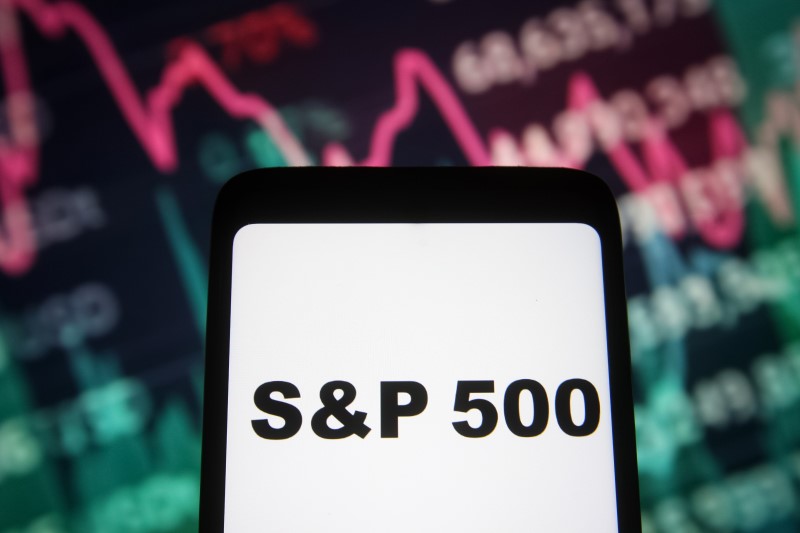By Lewis Krauskopf
NEW YORK (Reuters) -A reassuring economic outlook and dovish signals from the Federal Reserve are encouraging investors to look beyond the massive growth and technology stocks that have fueled the U.S. stock market’s gains over the past year.
Though rallies in stocks such as Nvidia (NASDAQ:) and Meta Platforms (NASDAQ:) have been the market’s main individual drivers in 2024, the financials, industrials and energy sectors are also outperforming the S&P 500’s 9.7% year-to-date gain. That has eased worries that the market was becoming increasingly tied to the fortunes of a small group of stocks.
A belief that the economy will remain resilient while inflation fades has prompted investors to look for winners outside of the megacaps. That view received a boost from the Fed earlier this week, when the central bank expressed confidence it would be able to tamp down inflation and cut interest rates this year, even as it raised its forecast for how much the U.S. economy will grow.
“There is more confidence that the Fed is going to be able to … get inflation approaching their longer-term targets without a recession,” said Scott Chronert, head of U.S. equity strategy at Citi, which is overweight the technology, financial and industrial sectors. “You are going to take a little bit more comfort that you can own a bank or an industrial if you think the Fed is going to lower rates at some point here.”
Investors in the coming week will be watching Friday’s personal consumption expenditures price index that will offer the latest read on inflation. The end of the first quarter also could prompt volatility as fund managers adjust their portfolios.
The broadening rally contrasts with last year, when uncertainty over the economic outlook prompted investors to seek shelter in the so-called Magnificent Seven group of megacap stocks, drawn by their dominant industry positions and strong balance sheets. Only the sectors that housed megacaps – tech, communication services and consumer discretionary – outperformed the S&P 500’s 24% gain last year.
This year, the financial and industrial sectors are up 10.1% and 9.9%, respectively, while energy has gained 10.3%.
More broadly, the Magnificent Seven – Apple (NASDAQ:), Nvidia, Alphabet (NASDAQ:), Tesla (NASDAQ:), Microsoft (NASDAQ:), Meta Platforms and Amazon.com (NASDAQ:) – have been responsible for 40% of the S&P 500’s gain as of Thursday, according to S&P Dow Jones Indices. That compares with a share of over 60% last year.
The wider rally “means that leadership isn’t so concentrated and susceptible to a correction,” said Robert Pavlik, senior portfolio manager at Dakota Wealth.
After the Magnificent Seven all posted huge gains in 2023, performance among them has diverged more this year, giving investors another reason to look at the rest of the market.
Enthusiasm over artificial intelligence has helped fuel a 90% gain in shares of Nvidia so far this year, while Microsoft has gained 14.5%. On the other side of the ledger, Apple and Tesla are down about 11% and 32%, respectively, for the year.
The latest blow for Apple came this week when the Department of Justice alleged the iPhone maker monopolized the smartphone market, highlighting the regulatory risks that could make investors wary of Big Tech.
In another sign of broadening, more stocks are outperforming the benchmark, 180 so far this year as of Thursday versus 150 last year.
Some corners of the market, such as small caps, still look subdued. The , which is focused on smaller companies, is up just 2.2% year-to-date.
Some investors believe the group could get a boost from the Fed’s outlook, which kept in place a previous forecast of three 25 basis-point interest rate cuts, despite the central bank’s upgraded growth projections.
“As the Fed starts to lower interest rates, that creates liquidity and makes financing easier,” said Jack Ablin, chief investment officer at Cresset Capital. “Who’s most advantaged? Not the megacap stocks that have unfettered access to capital no matter what rates are, but really the smaller, lesser-known names.”
The broadening trend could take a hit if the economy begins floundering or runs too hot, upsetting the so-called Goldilocks narrative that has supported markets in recent months.
Some investors also believe the market is due for a pullback after a run in which the S&P 500 has gained 27% since late October.
Others, however, are betting the trend will continue. Peter Tuz, president of Chase Investment Counsel, said his firm recently purchased shares of Goldman Sachs and oil services company Tidewater (NYSE:) while reducing its megacap holdings, including selling its Apple stake.
“The market is broadening out,” he said. “You’re just seeing that there’s more ways to make money this year than the Mag 7.”
Read the full article here







